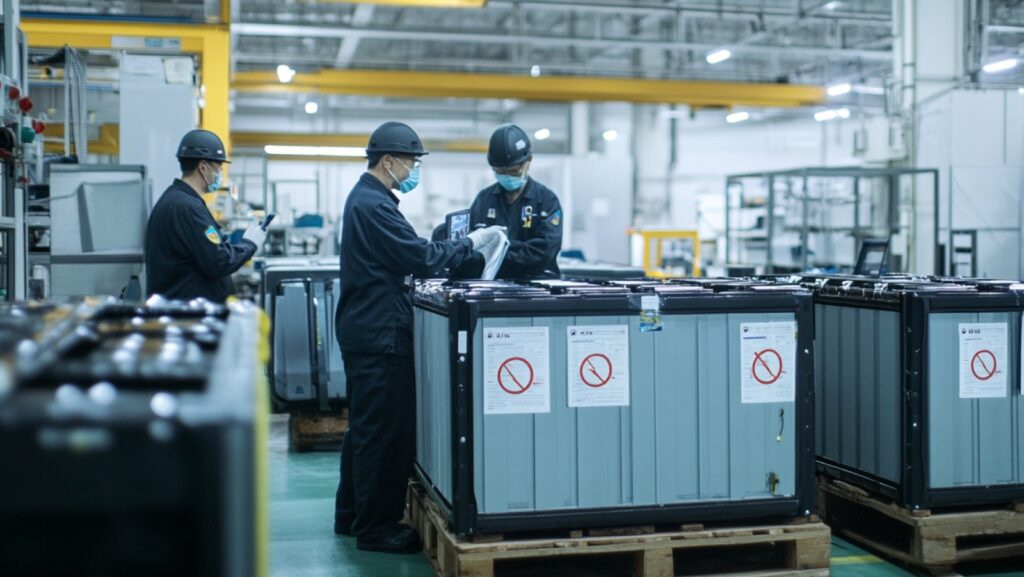
The transportation of EV batteries is a complex process governed by a myriad of regulations designed to ensure safety and compliance. Proper classification, packaging, and risk assessment are essential to mitigate the inherent risks associated with these powerful energy storage devices. As the demand for electric vehicles continues to grow, more batteries are entering the market and even more batteries are coming to the end of their lifecycle.
International Regulations on Transportation of Batteries
Transporting a battery is not an easy task. First of all, a battery might have different characteristics such as, for example, chemistry. Depending on its characteristics, a battery might be subject to different regulations. So, new lithium-ion batteries must meet the UN testing requirements. Used or damaged batteries are the subject of special packaging requirements while end-of-life batteries could be only transported if they meet stringent safety measures. Secondly, different batteries have different sizes, some of which can be up to 900 kg. This also presents a certain challenge. Based on the battery characteristics, there are packaging requirements to ensure safe transportation and minimize the negative impacts of external factors such as high temperatures and humidity.
These are regulations that apply to batteries and present requirements for labeling, packaging, and handling during transportation:
- ADR (European Agreement concerning the International Carriage of Dangerous Goods by Road) for road transport: the regulation came into force in 1968 and is regularly updated. It contains requirements for the transportation of dangerous goods by road.
- RID (Regulations concerning the International Carriage of Dangerous Goods by Rail) for rail transport: applies to both international and national transport of dangerous goods by rail in the European Union and other member states of COTIF (Convention concerning International Carriage by Rail).
- IMDG (International Maritime Dangerous Goods Code) for sea transport: is a crucial framework established to ensure the safe transport of dangerous goods by sea.
- ICAO/IATA for air transport: The ICAO/IATA guidance document contains the general information and requirements for lithium-ion batteries’ transportation, including labeling packaging standards, for air transport.
Batteries Transportation Risks
End-of-life (EOL) batteries, particularly lithium-ion batteries, pose significant transportation risks primarily due to their hazardous nature. Experts in battery transportation agree that these risks can lead to severe consequences if not managed properly.
“The biggest challenge in battery transportation lies mainly in ensuring the safety and efficiency parameters, especially with End-of-Life batteries. These batteries are not only heavy and contain hazardous materials but also require careful handling to facilitate repair, recycling and circularity.” – Yavuz Yildiz, R&D and Innovation Executive, DHL Supply Chain, commented.
In general, transportation risks are:
- Fire Hazards: Lithium-ion batteries contain flammable electrolytes which can lead to fires if the battery isn’t transported safely.
- Thermal Runaway: It can occur when a battery cell is damaged, leading to a chain reaction that generates excessive heat. This can lead to explosions and the release of toxic gases. The potential for thermal runaway increases with the energy density of the batteries, which is a growing concern as more powerful batteries are developed.
- Lack of Safety Measures: Many transport vessels may not be equipped to handle lithium-ion battery fires effectively. The specialized equipment and knowledge required to extinguish such fires are often lacking.
- Regulatory Challenges: As mentioned before, lithium-ion batteries are classified as hazardous materials,so those who want to transport them have to comply with strict regulations. These regulations vary by transport mode (air, sea, rail, etc.) and include requirements for packaging, labeling, and documentation to minimize risks. Another challenge is that some regulations lack specific information and also these regulations change with time.
“As there is no detailed standardisation on battery classification, there is a potential additional risk in the movement of reverse batteries which leads to the requirement of inefficient solutions to manage that risk. On top of that, the rapid growth of End-of-Life Batteries is only contributing negatively to the circularity challenge, especially in reverse logistics.” – Yavuz Yildiz, R&D and Innovation Executive, DHL Supply Chain.
Addressing the Battery Transportation Challenges
To address the most common risks, these actions could be taken:
- Ensure Enhanced Packaging: Batteries must be packaged in a manner that prevents short circuits and protects against physical damage. This includes using shock- and leak-proof materials.
- Provide Personnel Education and Training: Personnel involved in handling and transporting batteries should receive training on the specific risks and emergency procedures related to lithium-ion batteries. This is especially important as new regulations and requirements evolve.
- Provide Monitoring and Compliance: Continuous monitoring of battery conditions during transport, adherence to regulatory requirements, and thorough checks of cargo declarations are essential to ensure safety.
- Engage All Stakeholders in the Discussion: as there is no clear international classification of batteries, stakeholders have to work together to discuss and implement standards. “It is highly important that large players come together and force standardisation in both the legal transportation aspect as well as the processes of reverse logistics, such that batteries will be characterized and functioning cells in the future will not be scrapped.” – Yavuz Yildiz, R&D and Innovation Executive, DHL Supply Chain, commented.
The more the market develops, the more radically new challenges arise. The Recirculate project is one that addresses the most pressing issues in the second life of batteries. One of the consortium’s goals is to conduct comprehensive research about the battery transportation risks and possible solutions for their mitigation.